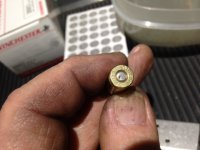Prof Young
New member
Third time out I put 100 Factory loads (Winchester) through it and 140 reloads (all Winchester primers).
The 100 factory loads ran without a hitch.
There is something about my reloads that sometimes this gun likes them and sometimes not. And it may even be the same cartridge. (Mind you the first 100 reloads I put through this gun ran like water as well.)
I can pull the trigger on an FTF for or five times and it still fails. Put that same cartridge in a moment later and it fires just fine. I don't get it.
On the FTF, when I go to eject them it takes quite a bit of force. Can't be an expanded shell as it didn't fire. And when I examine them there is a faint strike mark off center. See attached pic.
I can't figure out what it is about my reloads that would cause this strange on again off again malfunction in the gun.
Oh and these reloads run like water through my sig without a single glitch.
Help and suggestions would be much appreciated.
Live well, be safe
Prof Young
The 100 factory loads ran without a hitch.
There is something about my reloads that sometimes this gun likes them and sometimes not. And it may even be the same cartridge. (Mind you the first 100 reloads I put through this gun ran like water as well.)
I can pull the trigger on an FTF for or five times and it still fails. Put that same cartridge in a moment later and it fires just fine. I don't get it.
On the FTF, when I go to eject them it takes quite a bit of force. Can't be an expanded shell as it didn't fire. And when I examine them there is a faint strike mark off center. See attached pic.
I can't figure out what it is about my reloads that would cause this strange on again off again malfunction in the gun.
Oh and these reloads run like water through my sig without a single glitch.
Help and suggestions would be much appreciated.
Live well, be safe
Prof Young

